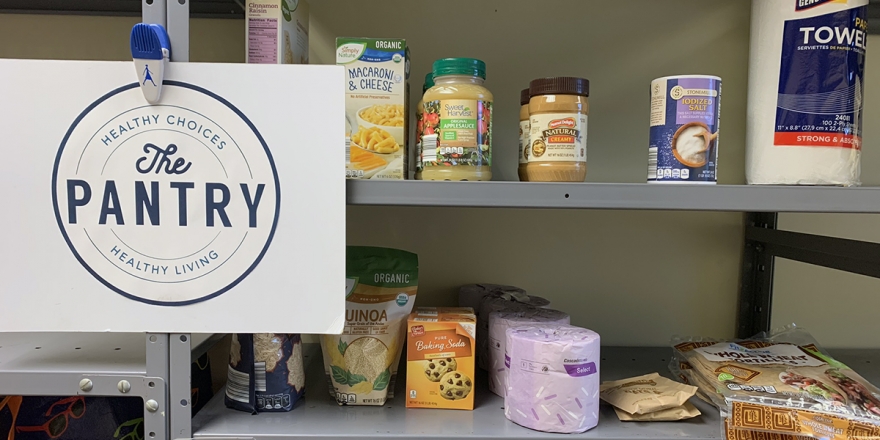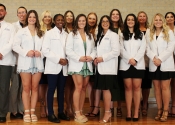
The Pantry: College of Saint Mary provides food assistance and resources for those in need
2/1/20 Update: Food Pantry and “2nd Bite” Programs Combat Food Insecurity
CSM is currently in the second year of its food pantry program titled, “The Pantry: Healthy Choices, Healthy Living.” As part of its expanded offerings for the 2019-20 school year, the university began a program called “2nd Bite Take and Go,” a sustainability initiative where excess food from the dining hall is made available to commuter students.
With the 2nd Bite Take and Go program, the extra food from the cafeteria is packaged and stored in a student lounge refrigerator for commuter students or for those who missed a meal in the dining hall. The meals are offered free of charge and are replenished every Tuesday and Thursday.
CSM began its food pantry program in response to the growing problem of food insecurity among college students. In a national report from 2018, researchers found that one-third of students felt uncertain about their ability to afford and acquire nutritious food.
The Pantry at CSM is offered to commuter students with an immediate need for healthy meal options. It also connects students with resources in the greater Omaha area for long-term support. The goal is to provide students with food assistance as well as to increase awareness of food insecurity and nutrition.
The Pantry offers cereal, grains, boxed dinners, canned fruits and vegetables and other non-perishable food items. This year, it also started providing hygiene products such as toilet paper and paper towels. To sign up to receive food from The Pantry, students go online and order through CSM’s Intranet system. The process is confidential.
Struggling students find ‘welcoming space’ at college food pantries throughout region
- Rick Ruggles, World-Herald Staff Writer -
Food pantries have popped up on college campuses across the Midwest and throughout the nation to lighten the financial hardships many students face.
Nebraska Wesleyan University opened its pantry last month. Creighton University opened its Creighton Cupboard in January. Metropolitan Community College is creating a program.
Numerous others, including the University of Nebraska-Lincoln and the University of Iowa, have started pantries within the past three years.
College has become far more expensive over time. And colleges see more first-generation students (the first in their families to attend) than they used to, and many of those students have less financial support from their parents than their classmates.
A national report last year estimated that well above one-third of students surveyed felt uncertain about their ability to afford and acquire nutritious food.
Katelyn Schwindt, a first-generation college student from Crescent, Iowa, works for the year-old food pantry at the College of St. Mary. She studies applied psychology and human services at the school.
Schwindt has three jobs, including a campus internship and a job in a Council Bluffs group home for the developmentally disabled. She said she, too, uses the pantry once a month to reduce her financial duress.
“A lot of students here are mothers and full-time workers and full-time students,” she said of the College of St. Mary.
The pantry, she said, is “super awesome.”
“College is not cheap, no matter where you go,” said Schwindt, a senior. “People should not be afraid to get help.”
In most cases, college food pantries are stocked with donated canned goods, pasta, beverages, hygiene products and other items provided by alumni, students, staffers and faculty members. Some also offer food that goes uneaten at college dining halls. Some help the students pursue government assistance, such as the Supplemental Nutrition Assistance Program.
The College Board, a national nonprofit group, said that even adjusting for inflation, the cost of going to public four-year colleges tripled from 1988 to 2018 and doubled for public two-year schools and private four-year colleges.
A lab at the University of Wisconsin surveyed 43,000 students at 66 colleges and published a report last year. The survey found that 36% of four-year university students and 42% at two-year colleges said they had been “food insecure” within the preceding 30 days.
Food insecurity is defined as limited or uncertain access to nutritionally adequate and safe food. The same survey found that similar percentages of students experienced “housing insecurity,” such as the inability to pay rent or the need to move frequently.
“The problem has always been there,” said Kristina Cammarano, assistant vice chancellor for student success at the University of Nebraska at Omaha. For years, she said, graduates bragged about surviving on ramen noodles.
Now, Cammarano said, colleges want to provide “a culture of care” because it’s not only unhealthy to go hungry, but it also affects academic performance and perseverance.
The College and University Food Bank Alliance estimated it has 790 member colleges, up from 240 in 2015.
A Government Accountability Office report late last year said that “rising college costs have outpaced federal and state grant aid and, over time, have led to an increasing share of the cost being borne by students and their families.”
The same report said that greater numbers of students from low-income homes are enrolling in college. For instance, the report said, the percentage of undergraduates who had household income under 130% of the federal poverty line jumped from 28% in 1996 to 39% three years ago.
Megan Patel, program coordinator for the Husker Pantry at UNL, said her program started in January 2017. Some students are “just trying to make a better life for them and their families” and don’t fit the stereotype of the financially comfortable college student.
“I think sometimes people feel if you can afford to go to college, you can afford ... food and all the costs of living that come with being on your own and being in college,” Patel said.
Rachel Pokora, a co-leader of the Prairie Wolf Pantry at Nebraska Wesleyan, said 25 people used the service in the first week.
Last spring a social work professor, Lisa Borchardt, listened to a student talk about having trouble concentrating because she hadn’t eaten that day.
Borchardt set out a table in her academic department for food donations. That led to creation this year of a formal food pantry, said Pokora, a professor of communication studies at Wesleyan.
“I think being a student has gotten more expensive,” Pokora said. “I’m sure that some students always have had this struggle. But more have that struggle now.”
At Creighton, students Denisse Navarro-Perez and Alexandra Van Cleave, both sophomores, work part time at the Creighton Cupboard in McGloin Hall.
They don’t dig into students’ finances or probe. If a person says he or she needs food, that is proof enough.
More than 60 students have signed up to use the pantry. The student workers said some students feel compelled to talk about why they need the pantry. Some are mothers. Some have had a bad turn in family finances. Some have parents going through miserable divorces.
“When you start college, you have this idea in your head of how it’s going to go,” Navarro-Perez said. Students cry sometimes when they describe their circumstances, the two pantry workers said.
“We want to create this welcoming space,” Van Cleave said. “We have a willing ear.”
They listen and let students browse through their racks of food and hygiene items. It’s a stopgap measure, but the pantry helps students over one more hurdle.











